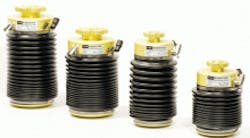Robots with force and touch sensitivity
Authored by: |
High-speed automation is a hallmark of the manufacturing industry. But some production processes are still carried out by hand because operations require touch sensitivity and force control. Grinding and polishing rough surfaces are but two examples.
The work is done manually because sensing the pressure applied by a moving machine or robot and precisely adjusting it in real time is a complicated and vexing problem. As a result, the few autonomous, force-sensitive tools on the market are either prohibitively expensive, require complex software, or give unsatisfactory performance.
The Active Contact Flange (ACF) from FerRobotics Technology GmbH in Linz, Austria, reportedly overcomes these limitations. The pneumatically powered, controlled-contact device mounts to a robot arm, and tools such as a sanding pad bolt on with a standard flange. In essence, it gives common industrial robots a sense of touch.
Controlling force
The ACF combines a pneumatic actuator, force and position sensors, and closed-loop controls that let it maintain a preset force on a work surface. Its proprietary pneumatic actuator is actually an actuator and force sensor in one, fully integrated into the flange. It was developed together with the Mechatronics Engineering Department and Institute for Robotics at the Johannes Kepler University Linz.
In practice, an operator or technician sets the intended force to be applied to the work face, say for a grinding head. Then, as the tool contacts the surface, the ACF senses the applied force, and servopneumatics quickly adjusts the actuator stroke and force to increase or decrease contact pressure as necessary to maintain the preset conditions.
The ACF works in tandem with a standard industrial controller. Standard I/Os link the self-regulated adapter to the overall robot-control program, but the internal ACF controls let it operate independently within its predefined range. Because the Active Contact Flange itself controls force output and motion, meticulous and costly programming of every tool movement in the higher-level robot-control system is unnecessary.
Thus, it can track surfaces with definable contact pressure and compensate for surface variations, which means preprogrammed robotic paths are not affected by tolerances on the workpieces and tools. So robot tolerances can be quite low, which favors low-cost or even used robots, resulting in an overall economical package.
Because integration is relatively simple, the ACF is compatible with all automation robots. Communication with the robot controls is via analog or digital signals, Ethernet, or standard fieldbus systems. Data signals simply communicate the predefined contact force to the Active Contact Flange, and report the position and contact conditions back to the main machine controls.
The product also incorporates an integrated passive safety system because air exhausts from the actuator even if a disturbance occurs faster than the regulator can react. This cushions shocks and impacts, considerably reducing the risk of damage in the event of a collision.
Automation applications
Combining the advantages of traditional robots with the Active Contact Flange results in a fast, precise, and stiff robot equipped with a compliant and touch-sensitive element with humanlike tactile sense. The system reportedly provides a new option for countless pressure-sensitive tasks which are, for the most part, still done manually.
According to FerRobotics officials, the ACF lends itself to surface-finishing operations such as polishing, sanding, grinding, cleaning, and deburring. For instance, it’s especially suited for monotonous surface finishing of stainless-steel and ceramic parts, where dust contamination can be hazardous to workers. It also works well in contact-sensitive handling and assembly processes such as packing, taping, inserting, and joining.
In the automobile industry, the ACF has been successfully tested for polishing operations on the Audi Q7. And windcraft manufacturers are investigating the flange for automated surface finishing of large parts.
MCE Stahl-und Maschinenbau GmbH, a Linz-based manufacturer of structural-steel construction components, is using the ACF for automated grinding of weld seams. For instance, workers at the company were tasked with grinding fillet welds on circular steel blanks more than 6 m in diameter, a strenuous job that required several days of manual labor. FerRobotics automated the process using an industrial crane, the Active Contact Flange, and a 4-kW belt sander weighing 70 kg. The system cut grinding time to about 30 min, improved consistency and quality, and offered a quick return on the investment. And capturing the grinding dust with an integrated industrial vacuum device enhanced worker safety.
Operating specs
The flanges come in four different sizes, the largest with a 318-mm length and 160‑mm diameter. They have 1 degree of freedom, offer contact force up to 500 N, stroke up to 100 mm, and carry payloads to 15 kg. The largest unit weighs 6.8 kg. The ACF will maintain force within ±0.3 N or less, and response time is 16 msec.
They run on 7-bar compressed air filtered to 30 μm per ISO 8573-1 cl.3, and air consumption is <10 lpm. Rated protection class is IP68, operating voltage is 24 Vdc, and operating ambient temperature range is 0 to 50°C. Optional versions are suitable for use with food products, in clean rooms, or in explosive environments.
